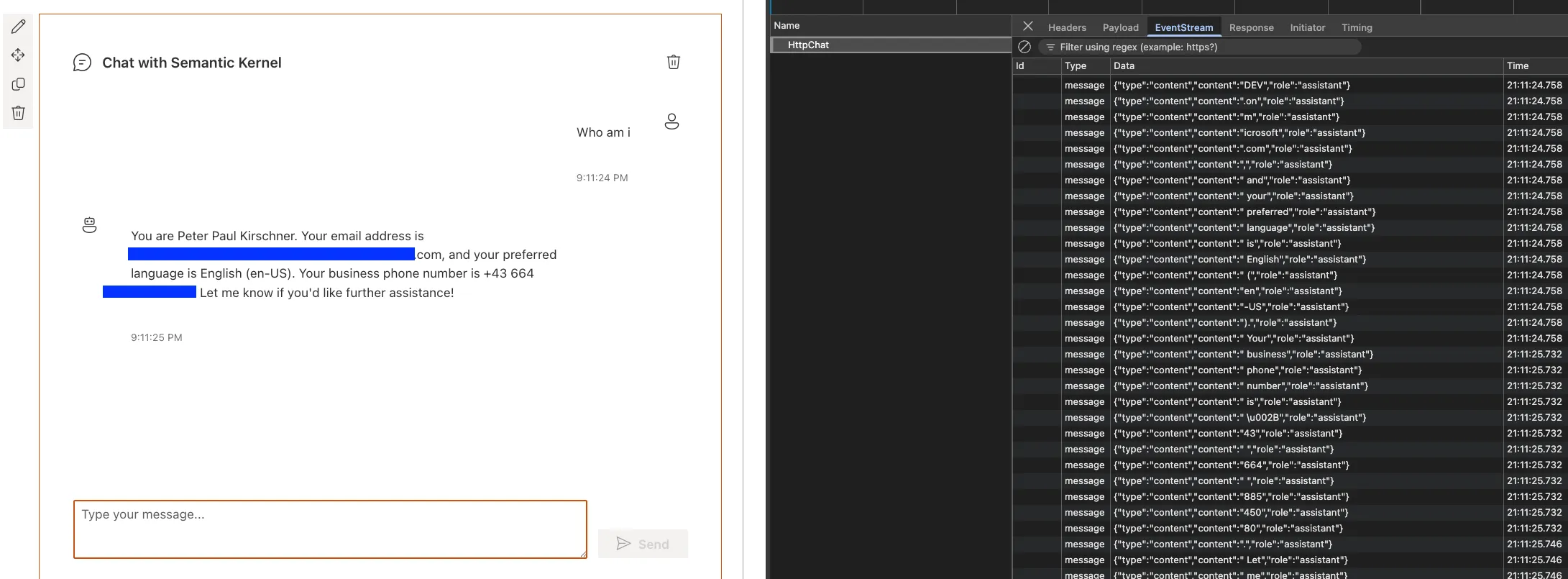Stream chat to your frontend with SSE in ASP.NET Core (.NET 10)

Server-Sent Events (SSE) is my favorite way to deliver token-by-token chat output to the browser. It’s simple, HTTP-friendly, and supported natively in modern browsers via EventSource. In this post, I’ll show how my streaming endpoint works end-to-end with ASP.NET Core (.NET 10) and Semantic Kernel (SK), then how the frontend listens and renders tokens.
I’ll add a network tab screenshot here to show the text/event-stream response and individual event frames.
Why SSE for chat
- Low-latency: tokens appear as they’re generated; no need to wait for the full response.
- Simple transport: one long-lived HTTP response with content-type
text/event-stream. - Built-in reconnection: the browser’s EventSource automatically retries.
Architecture
Frontend (EventSource) → SSE endpoint (/api/chat/stream) → Semantic Kernel chat service (streaming) → writes data: <delta> frames → flush → browser appends to UI.
Backend: ASP.NET Core SSE endpoint
Below is a minimal, production-ready pattern using ASP.NET Core Minimal APIs. It uses Semantic Kernel under the hood to talk to your chosen model (Azure OpenAI, OpenAI, or local). The important parts are:
- Set
Content-Type: text/event-streamand disable response buffering. - Iterate the streaming chat and write
data: ...\n\nframes. - Flush after each chunk.
- Send a final
event: donemarker.
using Microsoft.SemanticKernel;
using Microsoft.SemanticKernel.ChatCompletion;
using Azure.Identity; // optional, if you use Managed Identity
var builder = WebApplication.CreateBuilder(args);
// 1) Register SK and your chat completion service of choice
builder.Services.AddSingleton<IChatCompletionService>(sp =>
{
var kb = Kernel.CreateBuilder();
// Example: Azure OpenAI with Managed Identity (adjust to your environment)
// kb.AddAzureOpenAIChatCompletion(
// deploymentName: Environment.GetEnvironmentVariable("AZURE_OPENAI_DEPLOYMENT")!,
// endpoint: new Uri(Environment.GetEnvironmentVariable("AZURE_OPENAI_ENDPOINT")!),
// credential: new DefaultAzureCredential());
// Example: OpenAI API key
// kb.AddOpenAIChatCompletion(
// modelId: "gpt-4o-mini",
// apiKey: Environment.GetEnvironmentVariable("OPENAI_API_KEY")!);
var kernel = kb.Build();
return kernel.GetRequiredService<IChatCompletionService>();
});
var app = builder.Build();
// 2) SSE endpoint (GET). For POST bodies, prefer fetch streaming; EventSource only supports GET.
app.MapGet("/api/chat/stream", async (HttpContext http, IChatCompletionService chat, string q) =>
{
http.Response.Headers.CacheControl = "no-cache";
http.Response.Headers.Connection = "keep-alive";
http.Response.Headers["Content-Type"] = "text/event-stream";
var history = new ChatHistory();
history.AddSystemMessage("You are a concise, helpful assistant.");
history.AddUserMessage(q);
// Stream tokens from SK and forward as SSE frames
await foreach (var chunk in chat.GetStreamingChatMessageContentsAsync(history))
{
if (!string.IsNullOrEmpty(chunk.Content))
{
await http.Response.WriteAsync($"data: {chunk.Content}\n\n");
await http.Response.Body.FlushAsync();
}
}
// Send a final event so the client knows we’re done
await http.Response.WriteAsync("event: done\n");
await http.Response.WriteAsync("data: end\n\n");
await http.Response.Body.FlushAsync();
});
app.Run();Notes:
- If you need richer framing, you can also emit
id:andevent:lines for each message. - For long streams, send a periodic heartbeat comment (
:\n\n) to keep intermediaries from closing idle connections. - If you need POST (request body too large for a querystring), use
fetch()streaming instead of EventSource (see below).
Frontend: EventSource listener (browser)
This is the simplest client: it connects and appends tokens as they arrive. Works in all modern browsers.
<div id="out"></div>
<script>
const out = document.getElementById('out');
const q = encodeURIComponent('Explain SSE in two bullets.');
const es = new EventSource(`/api/chat/stream?q=${q}`);
es.onmessage = (ev) => {
out.textContent += ev.data;
};
es.addEventListener('done', () => {
es.close();
});
es.onerror = (err) => {
console.error('SSE error', err);
es.close();
};
</script>Alternative: fetch() streaming (POST support)
If you need to send a complex payload (files, RAG parameters, tools), use fetch with a POST endpoint that streams chunks in the response body.
async function streamChat(body: unknown) {
const res = await fetch('/api/chat/stream-post', {
method: 'POST',
headers: { 'Content-Type': 'application/json' },
body: JSON.stringify(body)
});
const reader = res.body!.getReader();
const decoder = new TextDecoder();
let text = '';
while (true) {
const { done, value } = await reader.read();
if (done) break;
text += decoder.decode(value, { stream: true });
// Append to UI...
}
return text;
}On the server, implement a POST endpoint that writes plain text chunks and flushes. You can still use SK’s streaming enumerator; you just won’t frame it as SSE, which is fine for fetch.

How SSE works (quick refresher)
- Content-Type is
text/event-stream. The server keeps the connection open. - Each message is one or more
data:lines followed by a blank line (\n\n). - Optional fields:
event:(named event),id:(for resume),retry:(reconnect delay). - Browsers reconnect automatically. You can support resume by emitting
id:and readingLast-Event-ID.
Production tips
- CORS: enable only for your frontend origin. SSE uses GET; ensure credentials policy matches your needs.
- Reverse proxies: keep-alive and buffering settings matter. For Nginx/Apache/Azure Front Door, disable response buffering for
text/event-stream. - Heartbeats: write
:\n\nevery ~15–30s to keep load balancers from timing out. - Error handling: consider emitting a final
event: errorframe with a sanitized message before closing. - Telemetry: log start/stop and token counts at the server, not inside the tight write loop.
What I’ll add next
- A devtools Network screenshot showing the event stream frames.
- A small retry/backoff wrapper for EventSource.
- A POST streaming variant wired to a RAG pipeline.
References
- SSE spec: https://html.spec.whatwg.org/multipage/server-sent-events.html
- Semantic Kernel chat completion (C#): https://learn.microsoft.com/semantic-kernel/concepts/ai-services/chat-completion/
- ASP.NET Core response streaming docs: https://learn.microsoft.com/aspnet/core/fundamentals/middleware/request-response?view=aspnetcore-8.0#response-streaming